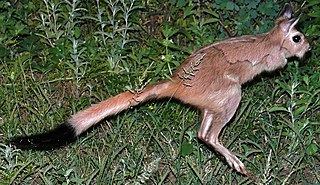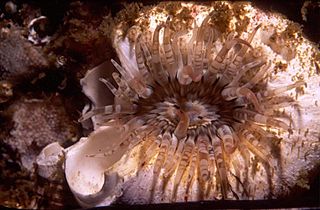
The South African springhare is a medium-sized terrestrial and burrowing rodent. Despite the name, it is not a hare. It is one of two extant species in the genus Pedetes, and is native to southern Africa. Formerly, the genus was considered monotypic and the East African springhare was included in P. capensis.

The marsh owl is a medium to large species of owl in the family Strigidae.

The Cape cormorant or Cape shag is a bird endemic to the southwestern coasts of Africa.

The spotted thick-knee, also known as the spotted dikkop or Cape thick-knee, is a wader in the family Burhinidae. It is native to tropical regions of central and southern Africa.

Sebastes capensis, the false jacopever or Cape redfish, is a species of marine ray-finned fish belonging to the subfamily Sebastinae, the rockfishes, part of the family Scorpaenidae. It is found in the South Atlantic Ocean and may also occur off southern and western South America.

The Cape eagle-owl is a species of owl in the family Strigidae. It is one of several large species of the eagle-owl genus Bubo.

The African grass owl is a species of owl in the barn owl family, Tytonidae.

The flower hat jelly is a species of hydromedusa in the hydrozoan family Olindiidae. Although they look like a jellyfish, they actually belong in the class Hydrozoa, while true jellyfish belong in class Scyphozoa. Flower hat jellies occur in the northwestern Pacific off central and southern Japan, and South Korea's Jeju Island.. The adult form of the flower hat jelly only lives a few months and is typically seen from December to July, with peaks in April and May. During the day they rest on the bottom, often among rocks or algae, but at night they float up to hunt for their prey, typically small fish.

The white-edged nudibranch, Coryphella capensis, previously known as Fjordia capensis, is a species of sea slug, specifically an aeolid nudibranch, a colourful sea slug. It is a marine gastropod mollusc in the family Coryphellidae.

Cratena capensis, the orange-eyed nudibranch, is a species of sea slug, specifically an aeolid nudibranch. It is a marine gastropod mollusc in the family Facelinidae.

Nucella squamosa, common name the scaly dogwhelk, is a species of sea snail, a marine gastropod mollusk in the family Muricidae, the murex snails or rock snails.

Trachylepis capensis is a species of skink, a lizard in the family Scincidae. The species is native to southern Africa.

Merluccius capensis is a ray-finned fish in the genus Merluccius, found in the south-eastern Atlantic Ocean, along the coast of South Africa. It is a long, lean fish with a large head, similar in appearance to the European hake and the deep-water Cape hake. By day, it lives close to the bottom on the continental shelf and upper slope at depths not usually exceeding 400 m (1,300 ft); it makes a large, daily vertical migration rising at night to feed in the nectonic zone, and it also migrates southwards in spring and northwards in autumn. It is an important commercial fish species in southern Africa.

Southern Afrotemperate Forest is a kind of tall, shady, multilayered indigenous South African forest. This is the main forest-type in the south-western part of South Africa, naturally extending from the Cape Peninsula in the west, as far as Port Elizabeth in the east. In this range, it usually occurs in small forest pockets, surrounded by fynbos vegetation.

The East African springhare, is not closely related to the hare, which is a lagomorph, but is a member of the Pedetidae, a rodent family.

The ring-tentacle anemone is a species of sea anemone in the family Isanthidae.

Candelabrum tentaculatum, also called the dreadlocks hydroid or calamari hydroid, is a sessile marine hydroid, that is found off the Cape Peninsula of South Africa.

Candelabridae is a small family of cnidarians within the class Hydrozoa. Myriothelidae Hincks, 1868 and Symplectaneidae Fraser, 1941 are now accepted as synonyms of this family.

Corhiza scotiae, the fine hydroid, is a delicate colonial hydroid in the family Halopterididae.



















